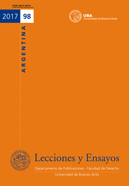El ánimo de apropiación como elemento del delito de hurto. Reflexiones a partir del plenario “Schneider”
Palabras clave:
derecho penal, hurto, delitos contra la propiedad, ánimo de apropiación, elemento subjetivo, incorrección moralResumen
El fin del presente trabajo es analizar si el delito de hurto requiere, además del apoderamiento de una cosa mueble ajena, un elemento subjetivo adicional: el ánimo de apropiación de la cosa. Para alcanzar ese objetivo, se analizarán los argumentos vertidos en el plenario “Schneider”, de la Cámara Nacional de Apelaciones en lo Criminal y Correccional, en el cual los jueces señalaron que el delito de hurto no requiere ningún elemento subjetivo adicional. En particular, se argumentará que la incorrección moral del hurto presupone ánimo de apropiación, ya que de ese modo el autor comunica un intenso mensaje de hostilidad contra el sistema de derechos de propiedad, lo que no se produce cuando solamente sustrae una cosa con la voluntad de devolvérsela al propietario.
Descargas
Citas
ABOSO, Gustavo, Código Penal de la República Argentina, Buenos Aires/Montevideo, B de F, 2012.
AVACA, Diego, IRIARTE, Ignacio y MARUM, Elizabeth, “Art. 162”, en D’ALESSIO, Andrés (dir.), Código Penal de la Nación, 2.ª ed., Buenos Aires, La Ley, 2009.
ALLENDE, Guillermo, “Breve análisis del decreto-ley 6582/58: registro de propiedad del automotor”, en Lecciones y Ensayos, n.º 9, 1958, pp. 77-82.
ASHWORTH, Andrew y HORDER, Jeremy, Principles of Criminal Law, 7.ª ed., Oxford, University Press, 2013.
BECKER, Lawrence, “Property”, en BECKER, Lawrence y BECKER, Charlotte (eds.), Encyclopedia of Ethics, vol. 3, New York, Routledge, 2001.
BREGLIA ARIAS, Omar y GAUNA, Omar, Código Penal y leyes complementarias, Buenos Aires, Astrea, 2007.
BYRD, Sharon y HRUSCHKA, Joachim, “The Natural Law Duty to Recognize Private Property Ownership: Kant's Theory of Property in His Doctrine of Right”, The University of Toronto Law Journal, vol. 56, n.º 2, 2006, pp. 217-282.
CAMADRO, Jorgelina, “El delito de hurto” en NIÑO, Luis (dir.), Delitos contra la propiedad, Buenos Aires, Ad-Hoc, 2011, pp. 35-59
CARNELLI, Lorenzo, “El hurto de uso en la doctrina y la legislación”, La Ley, t. 7 (sección doctrina), 1937, pp. 86 ss.
CLARKSON, Christopher, “Theft and Fair Labelling”, en The Modern Law Review, vol. 56, 1993, pp. 554–558.
CREUS, Carlos y BUOMPADRE, Jorge, Derecho penal. Parte especial, 7.ª ed., Buenos Aires, Astrea, 2007.
DONNA, Edgardo, Derecho Penal. Parte Especial, Buenos Aires, Rubinzal Culzoni, 2001, t. II-B.
ESTRELLA, Alberto y GODOY LEMOS, Roberto, Código Penal. Parte Especial. De los delitos en particular, 2.ª ed., Buenos Aires, Hammurabi, 2007.
FEINBERG, Joel, “The Expressive Function of Punishment”, en Doing and Deserving, Princeton, University Press, 1970, pp. 95-118.
FERRANTE, Marcelo, “Con el fin…”, Revista Jurídica de la Universidad de Palermo, núm. 9, 2008, pp. 27-44.
—, “Concepciones populares y reforma del derecho penal”, en Filosofía y Derecho Penal, Buenos Aires, Ad-Hoc, 2013, pp. 35-59.
FONTÁN BALESTRA, Carlos, Tratado de Derecho Penal, Buenos Aires, AbeledoPerrot, 1996, t. V, pp. 413-415.
FRÍAS CABALLERO, Jorge, La acción material constitutiva del delito de hurto, Buenos Aires, Abeledo Perrot, 1962.
FRISTER, Helmut, Derecho penal. Parte general, 4.ª ed., trad. de Marcelo SANCINETTI, Buenos Aires, Hammurabi, 2011.
GARGARELLA, Roberto, “Cuatro temas y cuatro problemas en la teoría jurídica de Luigi Ferrajoli”, en Revista de Derecho Penal y Procesal Penal, n,º 2, 2010, pp. 199-207.
GÓMEZ, Eusebio, Tratado de Derecho Penal, Buenos Aires, Argentina de Editores, 1939, t. IV, p. 77
GRECO, Luís, “Conveniencia y respeto: sobre lo hipotético y lo categórico en la fundamentación del Derecho penal”, InDret, 4/2010, consultado en [http://www.indret.com/pdf/768_es.pdf] el 20/03/2016.
GREEN, Stuart Thirteen Ways to Steal a Bicycle. Theft Law in the Information Age, Boston, Harvard University Press, 2012.
—, Mentir, hacer trampas y apropiarse de lo ajeno. Una teoría moral de los delitos de cuello blanco (trad. de SANLLEHÍ, AMORÓS BAS y ORTIZ DE URBINA GIMENO), Madrid (entre otras), Marcial Pons, 2013.
HILLENKAMP, Thomas, 40 Probleme aus dem Strafrecht. Besonderer Teil, 12.ª ed., München, Vahlen, 2013.
HILGENDORF, Eric y VALERIUS, Brian, Strafrecht. Allgemeiner Teil, 2.ª ed., München, C.H. Beck, 2015.
—, Strafrecht. Besonderer Teil II, München, C.H. Beck, 2017.
HRUSCHKA, Joachim, “La conducta de la víctima como clave para un sistema de los delitos patrimoniales que llevan consigo sustracción”, en Anuario de Derecho Penal y Ciencias Penales, vol. LIL, 1999, pp. 231-244.
JAKOBS, Günther Sobre la teoría de la pena, Bogotá, Universidad Externado de Colombia, 1998,
—, Sobre la normativización de la dogmática jurídico-penal, Madrid, Thompson/Civitas, 2003.
—, “La privación de un derecho como delito patrimonial. A la vez, una contribución a la generalización de la Parte Especial”, InDret, 4/2008, consultado en [http://www.indret.com/pdf/580.pdf] el 20/03/2016.
KINDHÄUSER, Urs la Strafrecht. Besonderer Teil II. Straftaten gegen Vermögensrechte, 8.ª ed. Baden-Baden, Nomos, 2014,
—, “§ 242”, en KINDHÄUSER, Urs, NEUMANN, Ulfrid y PAEFFGEN, Hans-Ullrich, Strafgesetzbuch, 4.ª ed., Baden-Baden, Nomos, 2013, t. 3.
—, “Fundamentos y sistemática de los delitos contra los derechos patrimoniales”, en Estudios de Derecho Penal Patrimonial, Lima, Instituto Peruano de Ciencias Penales/Editora Jurídica Grijley, 2002 (original de 1999), pp. 21-42.
—, “La apropiación en el hurto: objeto y límites”, en Estudios de Derecho Penal Patrimonial, Lima, Instituto Peruano de Ciencias Penales/Editora Jurídica Grijley, 2002 (original de 1995), pp.43-79.
KUBICIEL, Michael, Die Wissenschaft vom Besonderen Teil des Strafrechts, Frankfurt am Main, Vittorio Klostermann.
LAJE ROS, Cristóbal, La interpretación penal en el hurto, el robo y la extorsión, Córdoba, Lerner, 2013.
MARUM, Elizabeth, “Art. 162”, en BAIGÚN, David y ZAFFARONI, Eugenio Raúl (dir.), Código Penal y normas complementarias. Análisis doctrinal y jurisprudencial, Buenos Aires, Hammurabi, 2009, pp. 21-76.
MORENO, Rodolfo, El código penal y sus antecedentes, Buenos Aires, H.A. Tommasi, t. 5, 1922.
NAGEL, Thomas, The View from Nowhere, New York, Oxford University Press, 1986.
NÚÑEZ, Ricardo, Derecho Penal Argentino, Buenos Aires, Bibliográfica Omeba, 1976, t. V.
ODERIGO, Mario, Código Penal Anotado, 3.ª ed., Buenos Aires, De Palma, 1957.
PAWLIK, Michael, “Engaño por medio del aprovechamiento de defectos de organización ajenos”, en La libertad institucionalizada. Estudios de Filosofía Jurídica y Derecho penal, Buenos Aires/Madrid, Marcial Pons, 2010 (original de 2003), pp. 207-230.
—, Das unerlaubte Verhalten beim Betrug, Köln, Carl Heymanns Verlag, 1999.
—, Das Unrecht des Bürgers, Tübingen, Mohr Siebeck, 2012.
—, “El delito, ¿lesión de un bien jurídico?”, InDret, 2/2016, p. 10, consultado en [http://www.indret.com/pdf/1222.pdf] el 20/11/2016.
—, “Delito y pena en el Derecho penal del ciudadano”, en Ciudadanía y Derecho penal. Fundamentos de la teoría de la pena y del delito en un Estado de libertades, Barcelona, Atelier, 2016, pp. 38 ss.
PESSAGNO, Hernán, El hurto de uso y la legislación argentina, LL, t. 36, 1944, pp. 822-829.
RAMOS MEJÍA, Enrique, El hurto de uso, Jurisprudencia Argentina, 1945-II, pp. 143-146
RIGHI, Esteban, Delito de Estafa, Buenos Aires, Hammurabi, 2015.
ROMERO, Gladys, Los Elementos del Tipo de Estafa, Buenos Aires, Lerner, 1985.
RUSCA, Bruno, “¿Por qué está mal aceptar y ofrecer sobornos? Una discusión de la tesis de la mercantilización del gobierno”, en En Letra: Derecho Penal, n.º 2, pp. 86-104.
SANCINETTI, Marcelo, “La apropiación de cosa perdida como hurto atenuado”, en Sistema de la Teoría del Error en el Código Penal argentino, Buenos Aires, Hammurabi, 1990, p. 205).
—, Teoría del Delito y Disvalor de Acción, Buenos Aires, Hammurabi, 1991.
—, Casos de Derecho penal, 3.ª ed., Buenos Aires, Hammurabi, 2005.
SCHMIDHÄUSER, Eberhard y ALWART, Heiner, Strafrecht, Allgemeiner Teil, Studienbuch, Tübingen, Mohr Siebeck, 1982.
SCHMITZ, Roland, “§ 242”, en JOECKS, Wolfgang y MIEBACH, Klaus, Münchener Kommentar zum Strafgesetzbuch, 3.ª ed., München, C.H. Beck, 2012, t. 4.
SCHWARTZ, Louis y KAHAN, Dan, “Theft”, en Dressler, Joshua (ed.) Encyclopedia of Crime and Justice, vol. 4, New York, Macmillan, 2.ª ed., 2002.
SHUTE, Stephen y HORDER, Jeremy, “Thieving and Deceiving: What is the Difference?”, en The Modern Law Review, vol. 56, 1993, pp. 548–554.
SIMESTER, Andrew y SULLIVAN, Robert, “On the Nature and Rationale of Property Offences”, en DUFF, Antony y GREEN, Stuart (eds.), Defining Crimes: Essays on the Special Part of the Criminal Law, Oxford, University Press, 2005, pp. 169-195.
SINGER, Joseph, Introduction to Property, 2.ª ed., Boston, Aspen, 2005.
SOLER, Sebastián, Derecho Penal Argentino, 4.ª ed., Buenos Aires, TEA, 1987, t. IV.
TADROS, Victor, “Fair Labelling and Social Solidarity” en ZEDNER, Lucia y ROBERTS, John (eds.), Principles and Values in Criminal Law and Criminal Justice, Oxford, University Press, 2012, pp. 67-80.
TOZZINI, Carlos, Los Delitos de Hurto y Robo en la Legislación, la Doctrina y la Jurisprudencia, 2.ª ed., Buenos Aires, Lexis Nexis, 2002.
V. FEUERBACH, Anselm, Tratado de derecho penal (trad. ZAFFARONI y HAGEMEIER), 14.ª ed., Buenos Aires, Hammurabi, 2007 [original de 1801].
WESSELS, Johannes, BEULKE, Werner y SATZGER, Helmut, Strafrecht. Allgemeiner Teil. Die Straftat und ihr Aufbau, 43ª ed., Heidelberg/München/Landsberg/Frechen/Hamburg, C.F. Müller, 2013.
WILLIAMS, Glanville, “Convictions and Fair Labelling”, en The Cambridge Law Journal, vol. 45, n.º 1, 1983, pp. 85-95.
ZAFFARONI, Eugenio Raúl, SLOKAR, Alejandro y ALAGIA, Alejandro, Derecho Penal. Parte General, 2.ª ed., Buenos Aires, Ediar, 2002.
ZIFFER, Patricia, Lineamientos de la determinación de la pena, 2.º ed., Buenos Aires, Ad-Hoc, 1999.
Descargas
Publicado
Cómo citar
Número
Sección
Licencia

Esta obra está bajo una licencia internacional Creative Commons Atribución-NoComercial 4.0.











